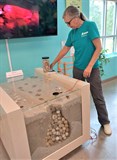
Our Topsail Turtle Project volunteers are out before sunrise every morning looking for turtle tracks. Once a nest is verified (not a false crawl) the location is assessed to make sure that it is not in danger of being disturbed by high tides and beach traffic, in which case it will be relocated to a safer spot. One egg is harvested from the nest and sent to University of Georgia for their ongoing maternal DNA study. That information tells us who mom is, and when and where any of her sisters (and sometimes her mom and in one case her grandmother) have nested. Pertinent information on our nest is logged, the nest is marked with stakes and orange tape and monitored daily by our beach volunteers. Not much else we humans can do at that point other than stay away until the hatch, about sixty days on average.
Meanwhile, deep in the sand, the fertilized eggs are incubating. Unlike chicken eggs there is no air pocket, so the embryo attaches directly to the inside of the shell and breathes through the porous membrane. That’s why sand quality is important. If the grains are too small, or the sand compacts (like during heavy rain or over-wash) there is little air circulation - not good.
Until about the middle third of the incubation period each embryo has an equal chance of being born a boy or a girl. At that point, a combination of temperatures (air, sand, position of the egg in the nest) determines the final ratio. For loggerheads, most of our nests, the pivotal temperature is 28.74°C. More girls will hatch from a warm nest, and more boys from cooler sand. Easy to remember if you just think “hot mamas and cool guys.”
Now that nature has determined the who it’s a matter of guessing the when. Our Turtle Project volunteers go into their own nesting mode – what we refer to as “nest sitting.” It’s just what it sounds like, but of course they don’t sit on top of the nest but alongside it. These little critters are slowly popping out of their shells, kicking their neighbors awake, and making their way up toward the top. And research has shown that they make different sounds as they go through the process. With the right equipment, you can hear what’s going on down there.
This year we have a new tool that should give us the ability to more accurately determine when a nest is ready to boil. Thanks to a donation we’ve been able to purchase several hydrophones that our volunteers will deploy at various stages of incubation. A small disc will be placed on top of the nest that will relay sounds through a cable, to a connector and then to a headset. As we gain experience using, identifying, and interpreting the sounds we’ll have a better idea of when a hatch will happen, and be ready and waiting for that brave, first hatchling to poke through the sand. Flippers crossed for success with this new (for us) tech.
Our tour schedule for June and July is seven days a week: Mon – Fri, 12-4; Saturday 11-3, and Sunday 11-2. Tickets must be purchased in advance through our website www.seaturtlehospital.org. You can visit the gift shop during those hours without taking the tour.
In addition to hooked and debilitated turtles, keep your eyes peeled for nesting mothers and turtle tracks. If you come across any sick, injured or nesting turtles immediately call our Director of Beach Operations, Terry Meyer at 910-470-2880. If she is not available, call the hospital during operating hours: 910-329-0222. After hospital business hours Terry can be reached on our phone by following the prompts to report a nest. The State of NC has a hotline for stranded, sick, and injured turtles (252-241-7367) which picks up 24/7. All conservation work for endangered sea turtles at KBSTRRC and on Topsail Island is authorized by the NC Wildlife Resources Commission, ES Permit 23ST05.



